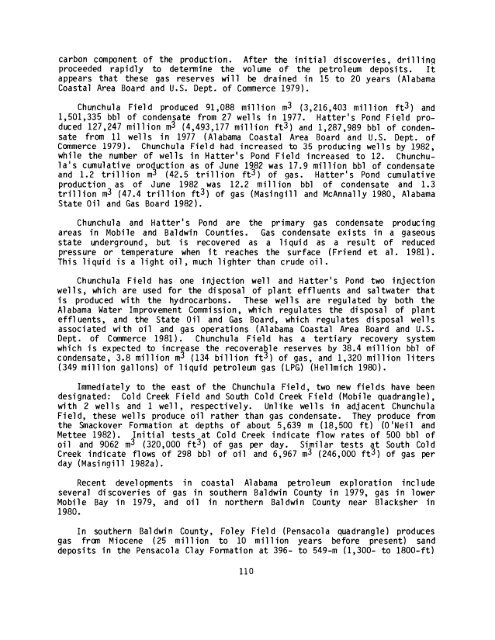ecological characterization atlas of coastal alabama - Data Center
ecological characterization atlas of coastal alabama - Data Center
ecological characterization atlas of coastal alabama - Data Center
You also want an ePaper? Increase the reach of your titles
YUMPU automatically turns print PDFs into web optimized ePapers that Google loves.
carbon component <strong>of</strong> the production . After the initial discoveries, drilling<br />
proceeded rapidly to determine the volume <strong>of</strong> the petroleum deposits . It<br />
appears that these gas reserves will be drained in 15 to 20 years (Alabama<br />
Coastal Area Board and U .S. Dept . <strong>of</strong> Commerce 1979) .<br />
Chunchula Field produced 91,088 million m3 (3,216,403 million ft3) and<br />
1,501,335 bbl <strong>of</strong> condensate from 27 wells in 1977 . Hatter's Pond Field produced<br />
127,247 million m3 (4,493,177 million ft3) and 1,287,989 bbl <strong>of</strong> condensate<br />
from 11 wells in 1977 (Alabama Coastal Area Board and U .S. Dept . <strong>of</strong><br />
Commerce 1979) . Chunchula Field had increased to 35 producing wells by 1982,<br />
while the number <strong>of</strong> wells in Hatter's Pond Field increased to 12 . Chunchula's<br />
cumulative Droduction as <strong>of</strong> June 1982 was 17 .9 million bbl <strong>of</strong> condensate<br />
and 1 .2 trillion m3 (42 .5 trillion ft3) <strong>of</strong> gas . Hatter's Pond cumulative<br />
production as <strong>of</strong> June 1982 was 12 .2 million bbl <strong>of</strong> condensate and 1 .3<br />
trillion m3 (47 .4 trillion ft3) <strong>of</strong> gas (Masingill and McAnnally 1980, Alabama<br />
State Oil and Gas Board 1982) .<br />
Chunchula and Hatter's Pond are the primary gas condensate producing<br />
areas in Mobile and Baldwin Counties . Gas condensate exists in a gaseous<br />
state underground, but is recovered as a liquid as a result <strong>of</strong> reduced<br />
pressure or temperature when it reaches the surface (Friend et al . 1981) .<br />
This liquid is a light oil, much lighter than crude oil .<br />
Chunchula Field has one injection well and Hatter's Pond two injection<br />
wells, which are used for the disposal <strong>of</strong> plant effluents and saltwater that<br />
is produced with the hy drocarbons . These wells are regulated by both the<br />
Alabama Water Improvement Commission, which regulates the disposal <strong>of</strong> plant<br />
effluents, and the State Oil and Gas Board, which regulates disposal wells<br />
associated with oil and gas operations (Alabama Coastal Area Board and U .S .<br />
Dept . <strong>of</strong> Commerce 1981) . Chunchula Field has a tertiary recovery system<br />
which is expected to increase the recoverable reserves by 38 .4 million bbl <strong>of</strong><br />
condensate, 3 .8 million m3 (134 billion ft3) <strong>of</strong> gas, and 1,320 million liters<br />
(349 million gallons) <strong>of</strong> liquid petroleum gas (LPG) (Hellmich 1980) .<br />
Immediately to the east <strong>of</strong> the Chunchula Field, two new fields have been<br />
designated : Cold Creek Field and South Cold Creek Field ( Mobile quadrangle),<br />
with 2 wells and 1 well, respectively . Unlike wells in adjacent Chunchula<br />
Field, these wells produce oil rather than gas condensate . They produce from<br />
the Smackover Formation at depths <strong>of</strong> about 5,639 m(18,500 ft) (O'Neil and<br />
Mettee 1982) . Initial tests at Cold Creek indicate flow rates <strong>of</strong> 500 bbl <strong>of</strong><br />
oil and 9062 m3 ( 320,000 ft3) <strong>of</strong> gas per day . Similar tests at South Cold<br />
Creek indicate flows <strong>of</strong> 298 bbl <strong>of</strong> oil and 6,967 m3 (246,000 ft3) <strong>of</strong> gas per<br />
day (Masingill 1982a) .<br />
Recent developments in <strong>coastal</strong> Alabama petroleum exploration include<br />
several discoveries <strong>of</strong> gas in southern Baldwin County in 1979, gas in lower<br />
Mobile Bay in 1979, and oil in northern Baldwin County near Blacksher in<br />
1980 .<br />
In southern Baldwin County, Foley Field (Pensacola quadrangle) produces<br />
gas from Miocene (25 million to 10 million years before present) sand<br />
deposits in the Pensacola Clay Formation at 396- to 549-m (1,300- to 1800-ft)<br />
110
















